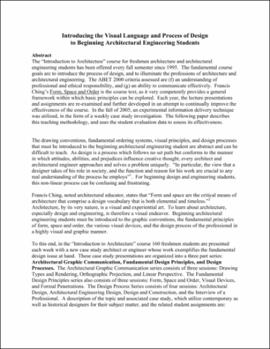| dc.description.abstract | The "Introduction to Architecture" course for freshmen architecture and architectural engineering students has been offered every fall semester since 1995. The fundamental course goals are to introduce the process of design, and to illuminate the professions of architecture and architectural engineering. The ABET 2000 criteria assessed are (f) an understanding of professional and ethical responsibility, and (g) an ability to communicate effectively. Francis Ching's Form. Space and Order is the course text, as it very competently provides a general framework within which basic principles can be explored. Each year, the lecture presentations and assignments are re-examined and further developed in an attempt to continually improve the effectiveness of the course. In the fall of 2005, an experimental information delivery technique was utilized, in the form of a weekly case study investigation. The following paper describes this teaching methodology, and uses the student evaluation data to assess its effectiveness. The drawing conventions, fundamental ordering systems, visual principles, and design processes that must be introduced to the beginning architectural engineering student are abstract and can be difficult to teach. As design is a process which follows no set path but conforms to the manner in which attitudes, abilities, and prejudices influence creative thought, every architect and architectural engineer approaches and solves a problem uniquely. "In particular, the view that a designer takes of his role in society, and the function and reason for his work are crucial to any real understanding of the process he employs"1. For beginning design and engineering students, this non-linear process can be confusing and frustrating. Francis Ching, noted architectural educator, states that "Form and space are the critical means of architecture that comprise a design vocabulary that is both elemental and timeless."2 Architecture, by its very nature, is a visual and experiential art. To learn about architecture, especially design and engineering, is therefore a visual endeavor. Beginning architectural engineering students must be introduced to the graphic conventions, the fundamental principles of form, space and order, the various visual devices, and the design process of the professional in a highly visual and graphic manner. To this end, in the "Introduction to Architecture" course 160 freshmen students are presented each week with a new case study architect or engineer whose work exemplifies the fundamental design issue at hand. These case study presentations are organized into a three part series: Architectural Graphic Communication, Fundamental Design Principles, and Design Processes. The Architectural Graphic Communication series consists of three sessions: Drawing Types and Rendering, Orthographic Projection, and Linear Perspective. The Fundamental Design Principles series also consists of three sessions: Form, Space and Order, Visual Devices, and Formal Penetrations. The Design Process Series consists of four sessions: Architectural Design, Architectural Engineering Design, Design and Construction, and the Interview of a Professional. A description of the topic and associated case study, which utilize contemporary as well as historical designers for their subject matter, and the related student assignments are: © American Society for Engineering Education, 2006. | |
